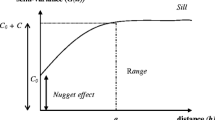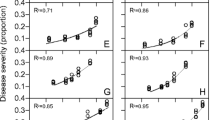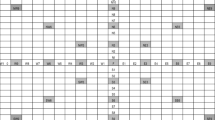Abstract
Disease progress of black rot in cabbage crop was studied over three years in field plots to compare the effects of uni-focal and multi-focal inoculum applied in equal amounts per plot. Disease progress (plant incidence and leaf incidence) was plotted over time, three dimensional maps were made, and disease aggregation was studied by means of geostatistics, black-black counts and Moran's I statistic. Black rot progress was primarily due to focus expansion. Secondary foci may appear at short distances from the initial focus but they usually merge with the expanding initial focus. Anisotropy occurred occasionally but was of minor importance. Disease proceeds faster in plots with multi-focal inoculation than in those with uni-focal inoculation. Probably, serious epidemics in Dutch cabbage fields originate from large numbers of foci.
Similar content being viewed by others
References
Alvarez AM and JJ Cho (1978) Black rot of cabbage in Hawaii: Inoculum source and disease incidence. Phytopathology 68: 1456-1459
Alvarez AM, Cho JJ and TM Hori (1987) Black rot of cabbage in Hawaii. Research Series 051/ Hawaii Institute of Tropical Agriculture and Human Resources ISSN 0197-9310
Butterworth J and JB McCartney (1991) The dispersal of bacteria from leaf surfaces by water splash. Journal of Applied Bacteriology 71: 484-496
Butterworth J and JB McCartney (1992) The removal and dispersal of foliar bacteria by rain splash. In: Stewart-Tull DES and Sussman M (eds) The release of genetically modified organisms. (pp 187-189) Plenum Press, New York
Campbell CL and LV Madden (1990) Introduction to plant disease epidemiology. John Wiley & Sons, New York
Chupp C and AF Sherf (1960) Vegetable diseases and their control. The Ronald Press Company, New York
Clayton EE (1929) Studies of the black-rot or blight disease of cauliflower. N. Y. State Agricultural Experiment Station Bulletin
Gill JL (1978) Design and analysis of experiments in the animal and medical sciences. Vol. 2. Iowa State University Press, Ames
Grimm R and Vogelsanger J (1990). Black rot disease on cabbage, irrigation and spreading. Proceedings of the 7th International conference on Plant Pathogenic Bacteria, Budapest, Hungary, June 11-16, 1989. pp. 225-229
Kocks CG and Ruissen MA (1998) Measuring field resistance of cabbage cultivars to black rot. Euphytica 91: 45-54
Kocks CG, Zadoks JC and Ruissen MA (1998) Spatio-temporal development of black rot (X. campestrispv. campestris) in cabbage to initial inoculum levels in field plots in the Netherlands (In press)
Kocks CG and Zadoks JC (1996) Cabbage refuse piles as sources of inoculum for black rot epidemics. Plant Disease 80: 789-792
Madden LV (1986) Statistical analysis and comparison of disease progress curves. In: Leonard KJ and WE Fry WE (eds) Plant disease epidemiology: Population dynamics and management (pp 38-84) Macmillan Publishing Company, New York
Matheron g (1962) Traité de géostatistique appliqué. Tome 1. Éditions Techniques, Paris
Mitchell DJ and Kannwischer-Mitchell ME (1983) Relationship of inoculum density of Phytophthoraspecies to disease incidence in various hosts. In: Erwin DC, Bartnicki-Garcia S and PH Tsao (eds) Phytophthora: Its biology, taxonomy, ecology and pathology (pp 259-269) American Phytopathological Society, St. Paul, MN
Moran PAP (1950) Notes on continuous stochastic phenomena. Biometrika 37: 17-23
Nicot PC, Rouse DI and Yandell BS (1984) Comparison of statistical methods for studying spatial patterns of soilborne plant pathogens in the field. Phytopathology 74: 1399-1402
Pinches A and Pallent LJ (1986) Rate and yield relationships in the production of xanthan gum by batch fermentations using complex and chemically defined growth media. Biotechnology and Bioengineering 28: 1484-1496
Ruissen MA, van der Gaag M and Toruno Lua (1990) Release of soil-borne Xanthomonas campestrispv. campestrisin the phyllosphere of cabbage plants. Proceedings of the 7th International Conference on Plant Pathogenic Bacteria, Budapest, Hungary, June 11-16, 1989, pp 299-303
Ruissen MA, van der Vossen RTM, Kocks CG (1993) Growth of Xanthomonas campestrispv. campestrispopulations at constant and variable temperatures. Netherlands Journal of Plant Pathology 99 Supplements 3: 173-179
Schaad NW and Dianese JC (1981) Cruciferous weeds as sources of inoculum of Xanthomonas campestrisin black rot of crucifers. Phytopathology 71: 1215-1220
Schaad NW, Sitterly WR and Humaydan H (1980) Relationship of incidence of seedborne Xanthomonas campestristo black rot of crucifers. Plant Disease 64: 91-92
Schaad NW and White WC (1974) Survival of Xanthomonas campestrisin soil. Phytopathology 64: 1518-1520
Shu H-H and Yang S-T (1990) Effects of temperature on cell growth and xanthan production in batch cultures of Xanthomonas campestris. Biotechnology and Bioengineering 35: 454-468
SPATANAL, 1992. A. Stein and I. G. Staritsky, 1992. Dept. of Soil Science and Geology of theWageningen Agricultural University. The Netherlands
Sokal RR and Oden L (1978a) Spatial autocorrelation in biology. 1. Methodology. Biological Journal Linn. Society 10: 199-228
Sokal RR and Oden L (1978b) Spatial autocorrelation in biology. 2. Some biological implications and four applications of evolutionary and ecological interest. Biological Journal Linn. Society 10: 229-249
Staub T and Williams PH (1972) Factors influencing black rot lesion development in resistant and susceptible cabbage. Phytopathology 62: 722-728
Strandberg JO (1973) Spatial distribution of cabbage black rot and the estimation of diseased plant populations. Phytopathology 63: 998-1003
Sutton JC and Williams PH (1970) Relation of xylem plugging to black rot lesion development in cabbage. Canadian Journal of Botany 48: 391-401
Walker JC, Larson RH and Taylor AL (1958) Diseases of cabbage and related plants. US Department of Agriculture. Handbook No. 144
Walker JC and Tisdale WB (1920) Observations on seed transmission of the cabbage black rot organism. Phytopathology 10: 175-177
Williams PH (1980) Black rot: A continuing threat to world crucifers. Plant Disease 64: 736-742
WLSFIT Version 2.0, 1992. G. B. M. Heuvelink. Weighted Least Squares FITting of variograms. Geographical Institute RUU. The Netherlands.
Zadoks JC (1961) Yellow rust on wheat, studies in epidemiology and physiological specialization. Tijdschrift der Planteziekten 67: 69-256
Zadoks JC and Van den Bosch F (1994) On the spread of plant disease: A theory on foci. Annual Review of Phytopathology 32: 503-521
Zawolek MW and Zadoks JC (1992) Studies in focus development: An optimum theorem for the dual dispersal of plant pathogens. Phytopathology 82: 1288-1297
Author information
Authors and Affiliations
Rights and permissions
About this article
Cite this article
Kocks, C.G., Zadoks, JC. & Ruissen, T.A. Response of black rot in cabbage to spatial distribution of inoculum. European Journal of Plant Pathology 104, 713–723 (1998). https://doi.org/10.1023/A:1008665511022
Issue Date:
DOI: https://doi.org/10.1023/A:1008665511022




